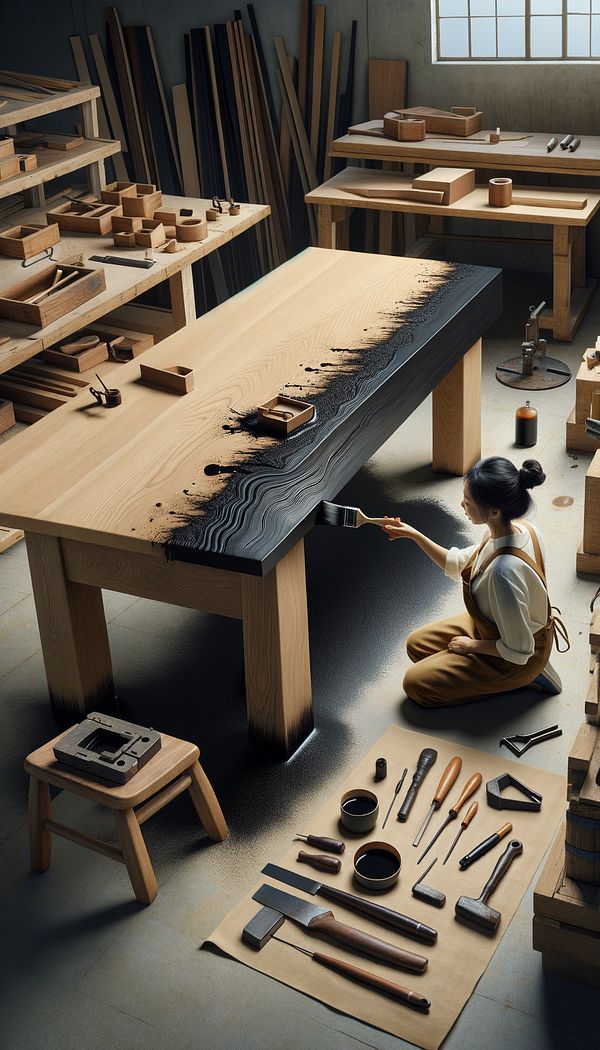What is Ebonize?
A method of darkening wood to mimic the appearance of ebony.
Description
Ebonizing is a fascinating and time-honored technique in the world of interior design and woodcraft, aiming to give wood the dark, rich appearance of ebony — a dense black hardwood. This practice allows designers and craftspeople to take advantage of the visual allure and sophistication of ebony's coloring, without the associated cost or ethical concerns related to sourcing the rare and expensive wood. Ebonizing works by either applying a chemical reaction to the tannins in the wood, which naturally darkens its color, or by using dyes and stains to achieve a similar effect. This method not only adds aesthetic value but also versatility, allowing lighter woods to be incorporated into design schemes that call for darker tones.
Ebonizing can be applied to a variety of wood types, each responding differently to the process based on its natural tannin content. Woods rich in tannins, like oak, react strongly to the chemical method, achieving a deep, permanent color change. For woods with less tannin, pre-treatment with a tannin-rich solution may be necessary before ebonizing. Regardless of the method, the goal is to achieve a finish that closely resembles the depth and luster of genuine ebony. Proper sealing and finishing are crucial following the ebonizing process to maintain the integrity of the wood's new color and to protect it from damage.
Usage
Ebonizing is commonly used in the manufacturing of furniture, flooring, and decorative objects, offering a cost-effective way to achieve a luxurious, sophisticated look. It is especially popular in designs aiming for a bold contrast or a statement piece, as the dark finish provides a striking visual against lighter colors and materials. Additionally, it has seen use in restoring antique furniture or in crafting musical instruments, where the appearance of ebony is desired without the ethical and financial implications of using actual ebony.
FAQs
-
Is ebonizing permanent?
Yes, especially when using the chemical reaction method on tannin-rich woods, the darkening effect of ebonizing is permanent. However, sunlight and wear can influence the color over time, so proper finishing and care are crucial to maintain its appearance.
-
Can all types of wood be ebonized?
While technically any wood can be ebonized, the effectiveness of the process and the depth of color achieved vary greatly depending on the wood's natural tannin content. Woods with high tannin levels, like oak, are ideal for ebonizing.
-
How is ebonizing different from simply staining wood black?
Ebonizing often involves a chemical reaction that changes the wood's color from within, offering a more durable and inherent color change compared to staining, which merely coats the surface. The ebonizing process can provide a finish that more closely mimics the natural appearance of ebony.
Practical Application
For those looking to apply the ebonizing technique, it's essential to start with a clean, sanded surface. If you're working with a low-tannin wood, consider a pre-treatment to enhance its reactivity. Always follow up with a suitable sealer to protect your work. Experimenting on small samples before applying it to your final piece can help you predict the outcome and adjust your process if needed.
-
Architectural Elements199 articles
-
Furniture Types599 articles
-
Decorative Techniques322 articles
-
Materials & Textiles360 articles
-
Flooring & Carpets48 articles
-
CaryatidA sculpted female figure serving as an architectural support.
-
BespokeBespoke refers to custom-made goods, specifically designed and tailored to the client's specifications.
-
BowbackA design feature in chairs where the back consists of a curved piece of wood.
-
WatercolorWatercolor is a painting method in which color pigments are suspended in water-based solutions.
-
VarietyVariety in interior design refers to the quality of being different or diverse.
